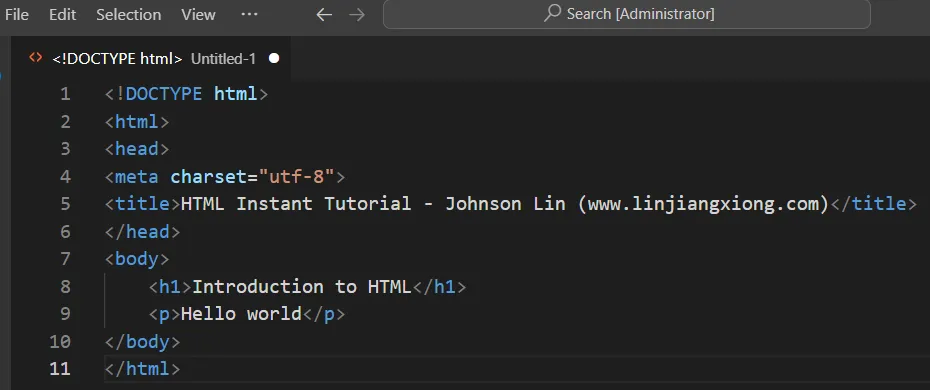Quotes and Basic Escape Characters in Bash
In Bash, quotes are used to handle special characters, manage spaces, and control how strings are interpreted. There are three primary types of quotes in Bash: Single Quotes (')Single quotes are used to preserve the literal value of each character within the quotes. No variable substitution or command substitution occurs within single quotes.Example:1echo 'This is a string with a $variable and a `command`'Output:1This is a string with a $variable and a `command`In this example,...
Comments in Bash
Comments in Bash scripts are used to annotate and explain the code. They help make the script more understandable and maintainable. In Bash, there are several ways to include comments: Single-Line CommentsSingle-line comments in Bash begin with a # character. Everything on the line after the # is considered a comment and is ignored by the Bash interpreter.1234#!/bin/bash# This is a single-line commentecho "Hello, World!" # This is also a comment Note: The top line of the script,...
Variables in Bash
In Bash scripting, variables are used to store data that can be used later in the script. Here’s a quick overview of how to work with variables in Bash: Defining VariablesVariables in Bash are defined by assigning a value to a name, with no spaces around the = sign:1variable_name=valueFor example:12name="Johnson"age=28 Note that there should be no spaces between the variable name and the equals sign, which might differ from what you’re used to in other programming languages....
Your First Bash Script
Bash, which stands for Bourne Again SHell, is a widely used command-line interpreter and scripting language that was originally developed by Brian Fox for the GNU Project as a free replacement for the Bourne shell (sh). Bash combines the features of the Bourne shell with many enhancements and new features, making it a powerful and flexible tool for users and system administrators. Before you start your first script, you need to understand the shebang(#!) character. What does #! Mean?The #!...
Introduction to Bash
Bash, short for “Bourne Again Shell,” is a command-line interface for Unix and Linux systems and is the default shell for most Linux distributions. What is a Shell?Before diving into Bash, it’s important to understand what a shell is. The term “shell” originally means “outer layer,” representing the interface between the user and the kernel. It provides a command-line environment where users interact with the operating system.In essence, a shell has several meanings: Program: The shell is a...
HTML Editors
Recommended HTML EditorsFor editing HTML, using a professional HTML editor can be very helpful. Here are a few commonly recommended editors: VS Code: https://code.visualstudio.com/ Sublime Text: http://www.sublimetext.com/ You can download the software from their official websites and follow the installation instructions. Next, we’ll demonstrate how to use VS Code to create an HTML file. Visual Studio CodeVisual Studio Code (VS Code) is a code editor developed by Microsoft. It is...
HTML Instant Tutorial
HTML is the foundation of web development. This tutorial provides a comprehensive introduction to HTML, serving both as an entry-level guide for beginners and a reference manual for looking up syntax. Table of Content Introduction to HTML Introduction to HTML URL HTML Element Attributes Understanding Text Encoding and Character Representation in HTML HTML Semantic Tags HTML Text HTML List HTML Image HTML <a> Tag HTML <link> Tag The <script> and <noscript> Tags HTML...
HTML Elements
This chapter introduces some recently adopted standard tags. <dialog>Basic UsageThe <dialog> tag represents a dialog box that can be closed. 123<dialog> Hello world</dialog> The above code shows a simple dialog box. By default, the dialog is hidden and does not display on the webpage. To make the dialog visible, you must add the open attribute. 123<dialog open> Hello world</dialog> The above code will display a box on the webpage with the content “Hello...
HTML Form
A form is a way for users to input information and interact with a webpage. In most cases, the information submitted by users is sent to the server. For example, a website’s search bar is a type of form. A form consists of one or more elements, such as text fields, buttons, radio buttons, or checkboxes. These elements are known as controls. <form>IntroductionThe <form> tag is used to define a form, which acts as a container for all the form elements. 123<form> <!--...
HTML Table
A Table displays data in rows and columns. <table>, <caption>The <table> tag is a block-level container that must enclose all the table content. 123<table> ... ...</table> The <caption>, which is always the first child element of <table>, provides the table’s title. This element is optional. 123<table> <caption>Example Table</caption></table> <thead>, <tbody>, and <tfoot>The <thead>, <tbody>,...
HTML iframe
The <iframe> tag is used to embed other web pages within the current webpage. Basic UsageThe <iframe> tag creates a specified area to display another web page. It acts as a container element. If the browser does not support <iframe>, it will show the nested content. 12345<iframe src="https://www.example.com" width="100%" height="500" frameborder="0" allowfullscreen sandbox> <p><a...
HTML Multimedia
Webpages can include not only images but also videos and audio. <video>The <video> tag is a block-level element used for embedding video. If the browser supports the video format, it displays a player; otherwise, it shows the content inside the <video> tag. Here’s an example code snippet: 123<video src="example.mp4" controls> <p>Your browser does not support HTML5 video. Please download the <a href="example.mp4">video...
The <script> and <noscript> Tags
The <script> tag is used to embed scripts, typically JavaScript, into a web page. The <noscript> tag specifies content to be displayed when a browser doesn’t support scripting or has it disabled. Using <script>The <script> tag is primarily used to load JavaScript code: 123<script>console.log('hello world');</script> This code will execute immediately when embedded in a webpage. Loading External Scripts: You can also use <script> to load...
HTML <link> Tag
OverviewThe <link> tag is primarily used to connect the current webpage with related external resources and is usually placed inside the <head> element. Its most common use is to load CSS stylesheets. 1<link rel="stylesheet" type="text/css" href="theme.css"> The code above loads the stylesheet theme.css for the webpage. In addition to the default stylesheet, a webpage can also load alternate stylesheets that are not applied by default but can...
HTML <a> Tag
IntroductionLinks (hyperlinks) are fundamental to the internet. They enable users to navigate from one webpage to another, connecting all resources online. The <a> tag represents a hyperlink. It allows users to link to other pages, text, images, files, or even specific sections within the same page. In essence, any resource on the web can be accessed via an <a> tag. Here’s an example of a typical link: 1<a href="https://wikipedia.org/">Wikipedia</a> In the...
HTML Image
Images are a crucial part of the internet, adding richness and variety to web pages. This chapter will cover how to insert images into a webpage. <img>The <img> tag is used to insert images and is a self-contained tag with no closing counterpart. 1<img src="foo.jpg"> The above code inserts an image foo.jpg into the webpage. The src attribute specifies the image’s URL, which in this case is a relative URL, indicating that the image is in the same directory as the...
HTML Lists
Lists are collections of organized items, primarily divided into two types: ordered and unordered.Ordered lists feature numbered items, displaying a clear sequence, like this:1231. Item A2. Item B3. Item CUnordered lists, on the other hand, use bullet points instead of numbers:123• Item A• Item B• Item C <ol>The <ol> tag creates an ordered list container. It automatically generates numbers for each list item. This tag is ideal for content where the order matters, such as...
HTML Text
Historically, web pages were mainly used for displaying text, so HTML includes a variety of text formatting tags. <div>The <div> tag is a generic container that represents a division or section in a document. It has no semantic meaning, so it’s often used as a block-level element when no other suitable tag is available.Its most common use is to provide CSS hooks for styling purposes. In the past, it was common to see deeply nested <div> elements for layout:1234567<div...
HTML Semantic Tags
HTML tags are designed to be semantic, meaning they convey the purpose and structure of the content they encapsulate. When using HTML, it’s crucial to choose tags that accurately represent the meaning of your content. This practice of semantic HTML naturally results in well-structured web pages that are easier for developers to read, write, and maintain. It also helps computers better process and understand web content. The Importance of Semantic HTMLOne of the key functions of HTML tags...
Understanding Text Encoding and Character Representation in HTML
IntroductionA webpage contains a large amount of text, and the browser needs to know the encoding method of this text in order to display it correctly.Typically, when a server sends an HTML file to the browser, it specifies the webpage’s encoding method through the HTTP header.1Content-Type: text/html; charset=UTF-8In the example above, the Content-Type field in the HTTP header first indicates that the data being sent by the server is of type text/html (i.e., an HTML page), and then...

